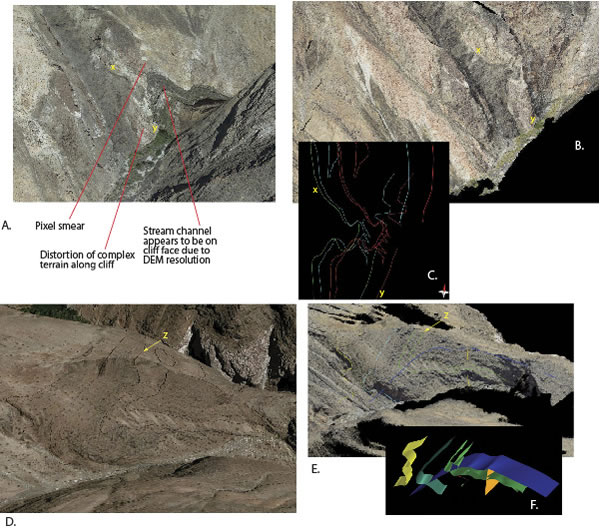
Figure 2.
Virtual scenes of the case study area in Surprise Canyon, California, USA (near 36.1133N, 117.1617W), illustrating errors introduced in conventional 2.5D methods (left, perspective views in Google Earth [A] and ArcGIS Pro [D]) versus approximately equivalent perspective views of georeferenced SfM point clouds obtained from oblique, ground-based photography (right). Insets (C) and (F) show local geologic interpretations with (E) and (F) described further in Figure 4. Several errors are apparent in the left scenes. In (A) and (B) (yellow [x] and [y] are equivalent points on the images and [C]) note the distortions and pixel smear in (A) versus true renderings in (B). (C) is a cyan-magenta stereo rendering of the lithologic contact between the dark and light units between (x) and (y) as well as two faults (white lines, rendered blue and red in the view, are from the SfM model and yellow, rendered green and red in the view); note how the 3D model allows 3D rendering of exposed fault faces as a jagged line versus the poor rendering of the faults from map drapes as well as superior 3D resolution of the contact in the SfM model. In scenes (D) and (E) note how errors in the 2.5D method introduce an artifact in D, labeled z, that could produce a major error in a geologic interpretation. In the left scene (D) rock units (outlined in black) clearly appear to dip to the right in this rendering and a three-point analysis of the scene would confirm this, yet the true dip is to the left, which is clear in the right scene (E) and in the field. (F) shows a visualization of structures present in the scene with the dark blue surface, indicating the folded axial surface of early isoclinal folds and the vertical orange plane showing the axial surface of a second generation antiform that warps the older fold system.